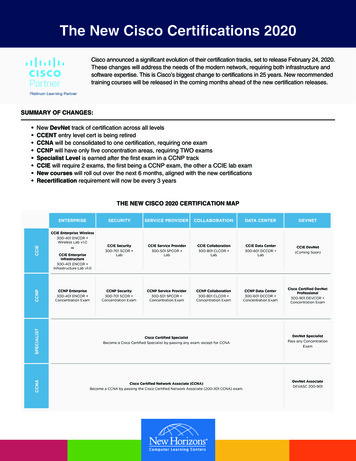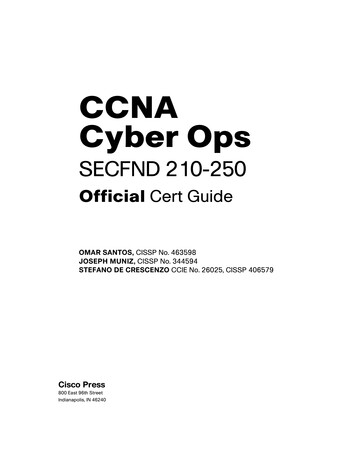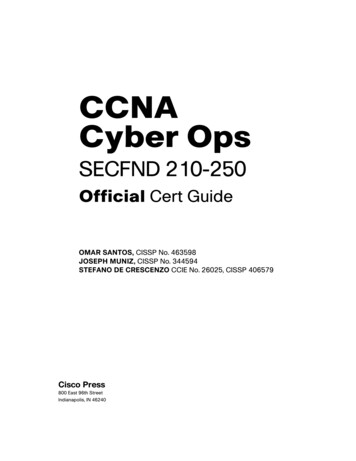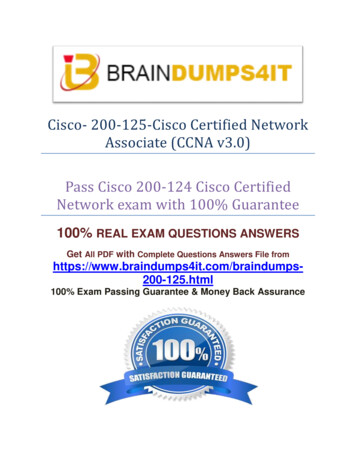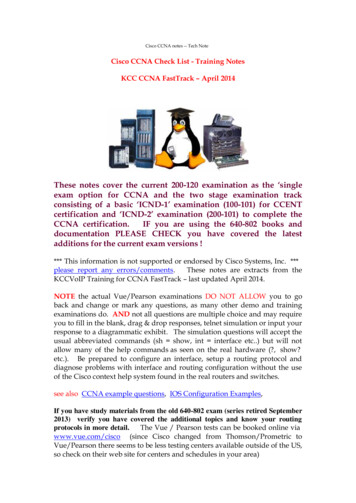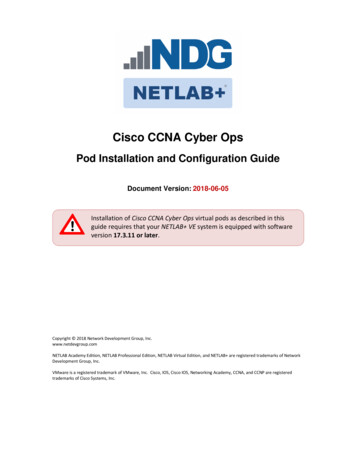
Transcription
Cisco CCNA Cyber OpsPod Installation and Configuration GuideDocument Version: 2018-06-05Installation of Cisco CCNA Cyber Ops virtual pods as described in thisguide requires that your NETLAB VE system is equipped with softwareversion 17.3.11 or later.Copyright 2018 Network Development Group, Inc.www.netdevgroup.comNETLAB Academy Edition, NETLAB Professional Edition, NETLAB Virtual Edition, and NETLAB are registered trademarks of NetworkDevelopment Group, Inc.VMware is a registered trademark of VMware, Inc. Cisco, IOS, Cisco IOS, Networking Academy, CCNA, and CCNP are registeredtrademarks of Cisco Systems, Inc.
Cisco CCNA Cyber Ops Pod Installation and Configuration GuideContents12345Introduction . 31.1 Introducing the Cisco CCNA Cyber Ops Pod. 3Planning. 42.1 Pod Resource Requirements . 42.2 ESXi Host Server Requirements. 52.3 NETLAB Requirements . 52.4 NETLAB Virtual Machine Infrastructure Setup. 52.4.1 Software Requirements . 62.5 Networking Requirements . 6Software and Licenses . 73.1 Obtaining Windows Software Licenses . 73.2 Obtaining Cisco Networking Academy Access . 83.3 Downloading OVF Files. 8Master Pod Configuration. 94.1 Deploying Virtual Machine OVF/OVA Files . 94.1.1 Modify Virtual Machines. 134.2 NETLAB Virtual Machine Inventory Setup. 144.3 Building the Master Cisco CCNA Cyber Ops Pod . 164.3.1 Enabling Cisco CCNA Cyber Ops in Course Manager . 164.3.2 Create the Master Pod . 164.3.3 Assign Virtual Machines to the Master Pod . 174.3.4 Snapshot the Virtual Machine . 184.3.5 Set the Revert to Snapshot . 214.3.6 Bring the Master Pod online . 224.4 Create Class and Schedule the Master Pod . 224.5 Make changes to the Master Pod . 224.5.1 Virtual Machine Credentials . 234.5.2 Provide Temporary Internet Access to the WinClient . 234.5.3 License and Activate the WinClient . 234.5.4 Shut down WinClient . 244.5.5 Reset the NIC to SAFETY NET . 244.5.6 Create Snapshot on the Changed Master Virtual Machines . 254.5.7 End Reservation . 25Pod Cloning . 265.1 Linked Clones and Full Clones . 265.2 Creating User Pods . 265.3 Copying Your Master Pod to the Second Host . 285.4 Creating User Pods on the Second Host . 295.5 Assigning Pods to Students, Teams, or Classes . 296/5/2018Copyright 2018 Network Development Group, Inc. www.netdevgroup.comPage 2
Cisco CCNA Cyber Ops Pod Installation and Configuration Guide1IntroductionThis document provides detailed guidance on performing the installation andconfiguration of the Cisco CCNA Cyber Ops pod on the NETLAB VE system.1.1Introducing the Cisco CCNA Cyber Ops PodThe Cisco CCNA Cyber Ops pod is a 100% virtual machine pod consisting of five virtualmachines. Linked together through virtual networking, these five virtual machinesprovide the environment for a student or a team to perform the Cisco CCNA Cyber Opslabs.6/5/2018Copyright 2018 Network Development Group, Inc. www.netdevgroup.comPage 3
Cisco CCNA Cyber Ops Pod Installation and Configuration GuidePlanning2This guide provides specific information pertinent to delivering the Cisco CCNA CyberOps Administration pod. The NETLAB Remote PC Guide Series provides theprerequisite guidance for setting up your VMware infrastructure, including: An introduction to virtualization using NETLAB .Detailed setup instructions for standing up VMware vCenter and VMware ESXi.Virtual machine and virtual pod management concepts using NETLAB .This document assumes that you have set up virtual machine infrastructure inaccordance with the NETLAB Remote PC Guide Series. The planning informationbelow refers to specific sections in the Remote PC Guide when applicable.2.1Pod Resource RequirementsThe Cisco CCNA Cyber Ops course will consume 37.1 GB of storage per each masterpod instance.The following table provides details of the storage requirements for each of the virtualmachines in the pod.Virtual MachineCyberOps WorkstationKaliMetasploitableSecurity OnionWinClientTotal6/5/2018OVF/OVA2.4 GB3.6 GB900 MB3.2 GB6 GB16.2Initial Master Pod(Thin Provisioning)5.7 GB8.3 GB1.8 GB9.7 GB11.6 GB37.1Copyright 2018 Network Development Group, Inc. www.netdevgroup.comPage 4
Cisco CCNA Cyber Ops Pod Installation and Configuration Guide2.2ESXi Host Server RequirementsPlease refer to the NDG website for specific ESXi host requirements to support virtualmachine delivery: nts/The number of active pods that can be used simultaneously depends onthe NETLAB product license and the number of VMware ESXi hostservers meeting the hardware requirements specifications.For current ESXi server requirements and active pod count, refer to the mote pc.html#vm host server specifications.2.3NETLAB RequirementsInstallation of Cisco CCNA Cyber Ops pods, as described in this guide, requires that yourNETLAB system is equipped with NETLAB VE version 17.3.11 or later.Previous versions of NETLAB do not support requirements for the Cisco CCNACyber Ops course on the physical host servers.Please refer to the NETLAB Remote PC Guide Series.2.4NETLAB Virtual Machine Infrastructure SetupThe NETLAB Virtual Machine Infrastructure setup is described in the followingsections of the NETLAB Remote PC Guide Series: Registering a Virtual Datacenter in NETLAB Adding ESXi hosts in NETLAB Proactive Resource AwarenessIt is important to configure Proactive Resource Awareness to maximizethe number of active pods per physical ESXi host.6/5/2018Copyright 2018 Network Development Group, Inc. www.netdevgroup.comPage 5
Cisco CCNA Cyber Ops Pod Installation and Configuration Guide2.4.1Software RequirementsFor the purpose of software licensing, each virtual machine is treated as an individualmachine, PC or server. Please refer to the specific vendor license agreements (andeducational discount programs, if applicable) to determine licensing requirements foryour virtual machines’ software, operating system and applications.The minimum virtual infrastructure software required for standing up this pod is in thefollowing table.Virtual Infrastructure RequirementsSoftwarevSphere ESXivCenter ServerVersion6.06.0Please refer to the Software and Licenses section regarding the software requirementsfor virtual machines in pod.2.5Networking RequirementsTo accommodate the movement of large VMs, OVF/OVAs, and ISO disk images from onehost to another, gigabit Ethernet or better connectivity is recommended to interconnectyour NETLAB , vCenter Server system and ESXi host systems.The two standard networking models recommended to interconnect your servers aredescribed in detail in the Networking Models section of the Remote PC Guide Series,Volume 1 - Introduction and Planning.6/5/2018Copyright 2018 Network Development Group, Inc. www.netdevgroup.comPage 6
Cisco CCNA Cyber Ops Pod Installation and Configuration Guide3Software and Licenses3.1Obtaining Windows Software LicensesThe following table lists the software that is required for the virtual machines inside theCisco CCNA Cyber Ops pod. Your organization needs to be a member of the vendorprograms listed in the Source column to obtain and use the licenses.Pod Software RequirementsSoftwareWindows ServerVersion2016 Standard (64-bit)SourceMicrosoft Imagine or VisualStudioTo enable all features of the Windows-based virtual machines, licensing will be required,followed through with activations for the master virtual machines only. This needs to bedone before cloning.There are two options for institutions to access Microsoft licenses. The first option isthrough the Visual Studio Subscription Portal. The second option is by accessing yourinstitution’s Kivuto WebStore via Microsoft Imagine.For more information about Visual Studio Subscriptions, you may visittheir FAQ page: https://www.visualstudio.com/my/myvsfaq.For more information regarding the Microsoft Imagine program, youmay visit their FAQ page: q.It is recommended to acquire the Multiple Activation Key (MAK) labkey license for a specified Windows product. This type of key enablesyou to activate multiple installations of a product with the same key.Please note that activating licenses is only required on master pods. Doing a Link Cloneof the master pod will preserve the activation on the cloned VMs in the user pods. It isimportant to note that when activating Windows, that the VMs have temporary Internetaccess so that they can contact Microsoft Licensing Servers. There are multiple ways ofproviding temporary Internet access for VMs in a vSphere environment. The mostcommon way is to temporarily assign the vNIC of the desired VM to connect to thevirtual switch that is connected to an outside facing physical NIC.6/5/2018Copyright 2018 Network Development Group, Inc. www.netdevgroup.comPage 7
Cisco CCNA Cyber Ops Pod Installation and Configuration Guide3.2Obtaining Cisco Networking Academy AccessTo obtain access to the Cisco CCNA Cyber Ops labs, your institution must be a CiscoNetworking Academy member.You can find information about the Cisco Networking Academy at the followinglink: Downloading OVF FilesThe virtual machines are made available as Open Virtualization Format (OVF) or OpenVirtualization Archive (OVA) files. These files are available for download from CSSIA.To request access to the preconfigured virtual machine templates from CSSIA:1.2.3.4.5.6.7.8.6/5/2018Go to the CSSIA Resources page: http://www.cssia.org/cssia-resources.cfm.Select VM Image Sharing Agreement – Image Sharing Agreement.Select VM Image Sharing Agreement to open the request form.Complete and submit your access request by following the instructions on therequest form.CSSIA will email a link, along with a username and password to access thedownload server. Access to the download server is provided only to customerswho are current with their NETLAB support contract and are participants in theappropriate partner programs (i.e. Cisco Networking Academy, VMware ITAcademy, Red Hat Academy, Palo Alto Academy, and/or EMC Academic Alliance).Once access to the download server has been established, the virtual machinescan be deployed directly to the vCenter Server by clicking on File Deploy OVFTemplate in the client window and copying the link into the location field.The deployment will start after the username and password are entered.Each virtual machine is deployed individually.Copyright 2018 Network Development Group, Inc. www.netdevgroup.comPage 8
Cisco CCNA Cyber Ops Pod Installation and Configuration Guide4Master Pod Configuration4.1Deploying Virtual Machine OVF/OVA FilesDeploy on your host server the pod virtual machine OVF/OVA files you havedownloaded.1. Navigate to your vSphere Web Client using your management workstation,ensure that your downloaded OVA/OVF files are accessible on this machine andthen connect to your vCenter Server.2. From the vSphere Web Client dashboard, select Hosts and Clusters.3. Right-click on the target ESXi Host Server and select Deploy OVF Template.6/5/2018Copyright 2018 Network Development Group, Inc. www.netdevgroup.comPage 9
Cisco CCNA Cyber Ops Pod Installation and Configuration Guide4. In the Deploy OVF Template window, on the Select source section, select theLocal File radio button and click Browse.5. Locate and select one of the VMs for the pod, click Open.Only one VM can be selected using this wizard. The process will have tobe repeated for the remaining VMs.6. Verify that the VM file path and name appears next to the Browse button andclick Next.6/5/2018Copyright 2018 Network Development Group, Inc. www.netdevgroup.comPage 10
Cisco CCNA Cyber Ops Pod Installation and Configuration Guide7. In the Review details section, make sure to fill the checkbox for Accept extraconfiguration options (if present) and click Next.6/5/2018Copyright 2018 Network Development Group, Inc. www.netdevgroup.comPage 11
Cisco CCNA Cyber Ops Pod Installation and Configuration Guide8. In the Select name and folder section, change the name of the virtual machine tosomething that is easy to manage. You can use the names provided in the listbelow as names for the virtual machines if you do not have a set namingconvention. Select the appropriate datacenter and click Next.VM NameCyberOpsWorkstationKaliMetasploitableSecurity OnionWinClientVM OSLinuxVirtual Machine Deployment NameCisco CCNA CyberOps.WorkstationLinuxLinuxLinuxWindowsServer 2016StandardCisco CCNA CyberOps.KaliCisco CCNA CyberOps.MetasploitableCisco CCNA CyberOps.Security OnionCisco CCNA CyberOps.WinClient9. In the Select Storage section, choose the appropriate storage device and makesure that Thin Provision is selected. Click Next.10. In the Setup networks section, select SAFETY NET as the destination and clickNext.If SAFETY NET is not available, refer to the Create a Safe StagingNetwork section in the Remote PC Guide Series – Volume 2.6/5/2018Copyright 2018 Network Development Group, Inc. www.netdevgroup.comPage 12
Cisco CCNA Cyber Ops Pod Installation and Configuration Guide11. In the Ready to complete section, make sure Power on after deployment isunchecked and confirm the settings. Click Finish.12. vCenter will begin deploying the virtual machine. This may take some timedepending on the speed of your connection, HDDs, etc. Repeat the previoussteps for each remaining virtual machine in the master pod.4.1.1Modify Virtual MachinesOnce the virtual machines are imported onto the host, verify the configurations. Thefollowing steps will guide you through the process.1. In the vSphere Web Client interface, right-click on the imported virtual machineand select Edit Settings.2. For all the virtual machines manually assign the MAC addresses for each NIC.The table below identifies the MAC addresses per NIC.Virtual MachineCyberOps WorkstationKaliMetasploitableSecurity :ab:b608:00:27:44:6c:a000:50:56:82:da:48Copyright 2018 Network Development Group, Inc. www.netdevgroup.comPage 13
Cisco CCNA Cyber Ops Pod Installation and Configuration Guide3. Repeat the previous steps for each of the remaining virtual machines in themaster pod.4.2NETLAB Virtual Machine Inventory SetupThis section will guide you in adding your templates to the Virtual Machine Inventory ofyour NETLAB VE system.1. Login into your NETLAB VE system using the administrator account.2. Select the Virtual Machine Infrastructure icon.6/5/2018Copyright 2018 Network Development Group, Inc. www.netdevgroup.comPage 14
Cisco CCNA Cyber Ops Pod Installation and Configuration Guide3. Click the Virtual Machine Inventory icon.4. Click the Import Virtual Machines button located at the bottom of the list.5. Select the appropriate datacenter from the list where your master VMs reside.6. Select the check box next to the virtual machines you had just deployed and clickImport Selected Virtual Machines.7. When the Configure VMs window loads, you can set your virtual machineparameters.a. Check the drop-down box for the correct operating system for eachimported virtual machine.b. Change Role to Master for each VM.c. Add any comments for each virtual machine in the last column.It is advised to leave the Version and Build numbers for reference whenrequesting NDG support.d. Verify your settings and click Import (X) Virtual Machines (notice thenumber in parenthesis is dynamic, depending on the amount of VMsselected).e. Verify all Import Statuses report back with OK and then click on theDismiss button.f. Verify that your virtual machines show up in the inventory.For additional information, please refer to the NETLAB VE Administrator Guide.6/5/2018Copyright 2018 Network Development Group, Inc. www.netdevgroup.comPage 15
Cisco CCNA Cyber Ops Pod Installation and Configuration Guide4.3Building the Master Cisco CCNA Cyber Ops PodThis section will assist you in adding the Cisco CCNA Cyber Ops pod to your NETLAB system.4.3.1Enabling Cisco CCNA Cyber Ops in Course ManagerPlease refer to the Course Manager section of the NETLAB VE Administrator Guide onhow to enable content. Please install the Cisco CCNA Cyber Ops course.4.3.2Create the Master Pod1. Log into NETLAB VE with the administrator account.2. Select the Pods icon.3. Create a new pod by scrolling to the bottom and clicking the Create New Podbutton.4. Then click on the Cisco CCNA Cyber Ops pod entry from the list of installed podtypes.6/5/2018Copyright 2018 Network Development Group, Inc. www.netdevgroup.comPage 16
Cisco CCNA Cyber Ops Pod Installation and Configuration Guide5. On the New Pod window, input a value into the Pod ID and Pod Name fields.Click Next.The Pod ID determines the order in which the pods will appear in thescheduler. It is best practice to use a block of sequential ID numbersfor the Pod Id that allows for the number of pods you are going toinstall.The Pod Name identifies the pod and is unique per pod. Here we usedthe name of the lab set or course in a shortened form along with a hostidentifier (H120), the type and number of the pod (M1000).6. To finalize the wizard, click OK.For additional information, please refer to the NETLAB VE Administrator Guide.4.3.3Assign Virtual Machines to the Master PodUpdate the master pod to associate the virtual machines with the newly created pod.1. To assign virtual machines to the master pod on your NETLAB system, select thePods icon.6/5/2018Copyright 2018 Network Development Group, Inc. www.netdevgroup.comPage 17
Cisco CCNA Cyber Ops Pod Installation and Configuration Guide2. Select the Cisco CCNA Cyber Ops master pod from the pod list.3. Click on the Action dropdown next to the virtual machine you are about toassign and select Attach VM.4. Select the corresponding virtual machine from the inventory list.5. Repeat the previous steps for the remaining virtual machines.4.3.4Snapshot the Virtual Machine1. In the pod list, click on the Cisco CCNA Cyber Ops master pod you just assignedmachines to.6/5/2018Copyright 2018 Network Development Group, Inc. www.netdevgroup.comPage 18
Cisco CCNA Cyber Ops Pod Installation and Configuration Guide2. In the pod view, click on a virtual machine in the list to view the properties ofthat machine in NETLAB . You will need to do this for each of the virtualmachines in the list.3. In the pod virtual machine view, click on the Snapshots button to open theSnapshot Manager.4. In the Snapshot Manager window, click on the Take button. This will take asnapshot of the current state of the virtual machine.Any changes made after this will require a new snapshot or thosechanges will not reflect in the reset state of the pod or its clones.6/5/2018Copyright 2018 Network Development Group, Inc. www.netdevgroup.comPage 19
Cisco CCNA Cyber Ops Pod Installation and Configuration Guide5. In the Take Snapshot window, type GOLDEN MASTER in the Name field then clickthe OK button.It is recommended to use GOLDEN MASTER as the snapshot namewhen working with normalized pod types.6. In the Snapshot Manager window, notice the snapshot is created. Click theDismiss button.At this point it is good to verify that you have only one snapshot on thevirtual machine. Multiple snapshots increase the likelihood of havingproblems, especially if the snapshots are named the same.6/5/2018Copyright 2018 Network Development Group, Inc. www.netdevgroup.comPage 20
Cisco CCNA Cyber Ops Pod Installation and Configuration Guide6. Click the Dismiss button to return to the pod view page and repeat the previoussteps for the remaining virtual machines.4.3.5Set the Revert to Snapshot1. In the pod view, click on a virtual machine in the list to view the properties ofthat machine in NETLAB . You will need to do this for each of the virtualmachines in the list.2. In the pod virtual machine view, click on the Settings button.3. In the virtual machine’s Settings window, click on the Revert to Snapshot dropbox and select GOLDEN MASTER then click the Submit button.This sets the snapshot on the virtual machine that will get reverted toeach time the pod is scheduled.4. Click OK to confirm.5. Click the Dismiss button to return to the pod view page and repeat the previoussteps for the remaining virtual machines.6/5/2018Copyright 2018 Network Development Group, Inc. www.netdevgroup.comPage 21
Cisco CCNA Cyber Ops Pod Installation and Configuration Guide4.3.6Bring the Master Pod onlineIn the pod view, click the drop arrow under State and select Online.4.4Create Class and Schedule the Master PodCreate a class as identified in Add Classes section of the NETLAB VE Instructor Guidethen schedule the Master Pod to license the WinClient machine.When scheduling the Master Pod, it is important to schedule the podfor enough time to complete the following steps. Failure to completethe steps prior to taking the final snapshot could mean redeployingnecessary virtual machines.4.5Make changes to the Master PodSome pods have software that needs to be altered on the host machine before it can beused properly. This normally happens when software requires licenses to function.If there are changes that need to be made to the master pod prior to link cloning eitherstudent pods or full cloning other master pods on other hosts, you will need to followthis set of instructions to ready your master pod.For the Cisco CCNA Cyber Ops master pod you will need to license the WinClientmachine. This process consists of: Scheduling the master pod Providing temporary internet access to the WinClient machine Licensing/Activating the WinClient Shutting down the WinClient only If necessary, resetting the network interface cards to SAFETY NET Taking a new GOLDEN MASTER snapshot for WinClient Ending the reservation6/5/2018Copyright 2018 Network Development Group, Inc. www.netdevgroup.comPage 22
Cisco CCNA Cyber Ops Pod Installation and Configuration Guide4.5.1Virtual Machine CredentialsFor your reference, the following table provides a list of the credentials for the systemsin the pod:MachineCyberOps WorkstationKaliMetasploitableSecurity OnionWinClient4.5.2User dcyberopscyberopsmsfadmincyberopscyberopsProvide Temporary Internet Access to the WinClient1. Outside the NETLAB interface, navigate to your vSphere Web Client using yourmanagement workstation, and then connect to your vCenter Server.2. From the vSphere Web Client dashboard, select Hosts and Clusters.3. Select your host under the NETLAB datacenter.4. Locate the WinClient virtual machine. Right-click on the virtual machine andselect Edit settings.5. Change Network adapter 1 to a virtual machine port group that is linked to aninternet accessible physical adapter.6. Click OK to confirm settings.4.5.3License and Activate the WinClient1. Log on to the WinClient machine in the pod. If necessary, click the drop-downarrow and select Send CTRL ALT DEL.2. Log in as Administrator with cyberops as the password.3. Once logged in, make sure the IP/TCP settings are temporarily configuredcorrectly so that the Internet is reachable. This can vary depending on how yourenvironment is set up.4. Right-click on the Start menu and select System.6/5/2018Copyright 2018 Network Development Group, Inc. www.netdevgroup.comPage 23
Cisco CCNA Cyber Ops Pod Installation and Configuration Guide5.6.7.8.4.5.4In the Windows activation pane, click the Activate Windows link.Click Change product key.Enter the product key and then click Next.Windows should now be activated. If your received an error, make sure that thekey entered is valid and click the Troubleshoot link from the Activation Settings.Shut down WinClient1. Click the Start menu followed by clicking the Power icon.2. Click Shut down.3. When prompted, choose Other (Planned) and click Continue.4.5.5Reset the NIC to SAFETY NET1. Outside the NETLAB interface, navigate to your vSphere Web Client using yourmanagement workstation, and then connect to your vCenter Server.2. From the vSphere Web Client dashboard, select Hosts and Clusters.3. Select your host under the NETLAB datacenter.4. Locate the WinClient machine. Right-click on the virtual machine and select Editsettings.5. Change Network adapter 1 to SAFETY NET.6. Click OK to confirm settings.6/5/2018Copyright 2018 Network Development Group, Inc. www.netdevgroup.comPage 24
Cisco CCNA Cyber Ops Pod Installation and Configuration Guide4.5.6Create Snapshot on the Changed Master Virtual Machines1. Right-click on the WinClient virtual machine and select Snapshots- ManageSnapshots 2. Click Delete to delete the current snapshot. Remember the name of thissnapshot as the new snapshot will need to have the exact same name.3. Click Yes on the Confirm Delete window.4. Click Close on the Manage Snapshots window.5. Right-click on the Client virtual machine and select Snapshots- Take Snapshot 6. In the Take Snapshot window, type GOLDEN MASTER or whatever prior snapshotname the virtual machine had from step 2. Click OK to take snapshot.4.5.7End ReservationYou may now end the reservation of the master pod.6/5/2018Copyright 2018 Network Development Group, Inc. www.netdevgroup.comPage 25
Cisco CCNA Cyber Ops Pod Installation and Configuration GuidePod Cloning5This section will help you create multiple student pods. The following sections describethe NETLAB pod cloning feature used to create student pods on one or two hostsystems.5.1Linked Clones and Full ClonesNETLAB can create linked clones or full clones.A linked clone (or linked virtual machine) is a virtual machine that shares virtual diskswith the parent (or master) virtual machine in an ongoing manner. This conserves diskspace, and allows multiple virtual machines to use the same software installation.Linked clones can be created very quickly because most of the disk is shared with theparent VM.A full clone is an independent copy of a virtual machine that shares nothing with theparent virtual machine after the cloning operation. Ongoing operation of a full clone isentirely separate from the parent virtual machine.5.2Creating User PodsThe following section describes how to create user pods on the same VMware Hostsystem that holds your master pod's virtual machines. In this scenario, we will createlinked virtual machines using the NETLAB pod cloning utility.1. Login into NETLAB VE with the administrator account.2. Select the Pods icon.3. Click on your master pod.4. Make sure the pod is offline by selecting Take Pod Offline.5. Click the Clone Pod button to create a new pod based on the settings andsnapshots of this pod.6. Input a new ID value into the New Pod ID field. It is advised to keep the pods innumerical order. If the pod IDs are not in numerical order, they will not show upin the scheduler in numerical order. Click Next.6/5/2018Copyright 2018 Network Development Group, Inc. www.netdevgroup.comPage 26
Cisco CCNA Cyber Ops Pod Installation and Configuration Guide7. Enter a name for the cloned pod into the New Pod Name field. For example,Cisco CCNA CyberOps Pod1. Click Next.8. When the action has finished processing, you are
configuration of the Cisco CCNA Cyber Ops pod on the NETLAB VE system. 1.1 Introducing the Cisco CCNA Cyber Ops Pod : The : . To obtain access to the Cisco CCNA Cyber Ops labs, your institution must be a Cisco Networking Academy member. You can find information about the Cisco Networking Academy at the following
